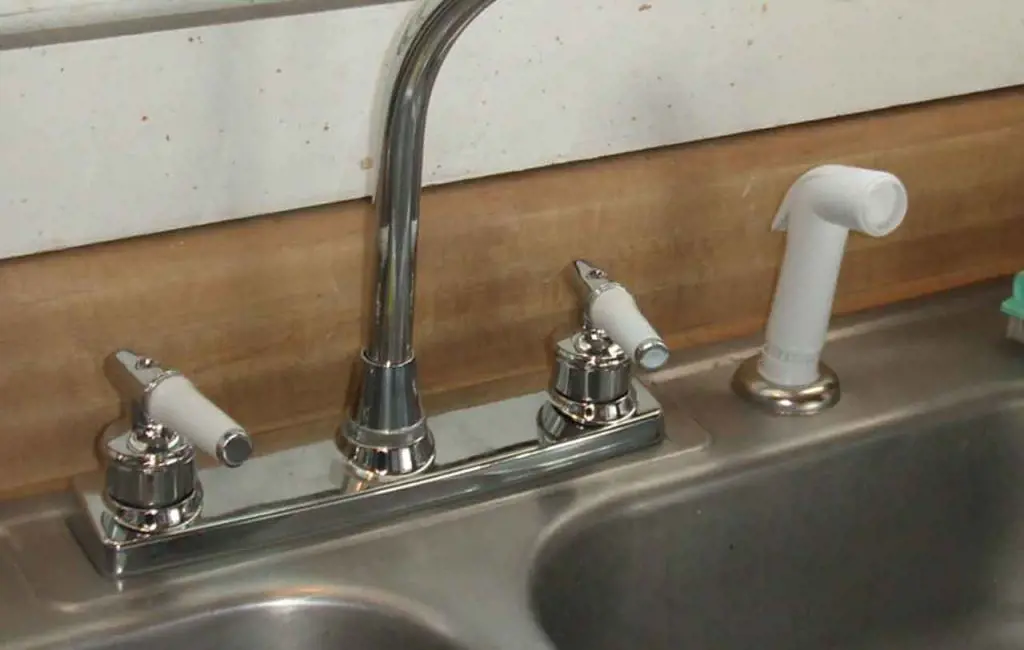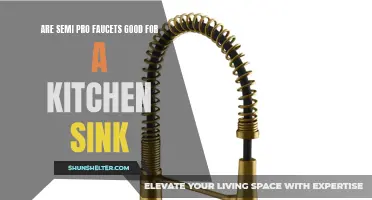
Have you ever been startled by a loud thumping sound coming from your kitchen faucet? If so, you may be wondering what could possibly be causing this mysterious noise. Don't worry, you're not alone. Many homeowners experience this strange phenomenon and are left scratching their heads in confusion. In this article, we will explore the possible reasons behind why your kitchen faucet is thumping and provide some potential solutions to put an end to the noise once and for all. So, let's dive in and uncover the source of this unsettling sound!
| Characteristics | Values |
|---|---|
| Water Hammer | Faulty water hammer arrestor or air chamber |
| Loose or Worn Parts | Loose pipes, connections, or worn internal parts |
| High Water Pressure | Excessive water pressure |
| Sediment Build-up | Sediment blocking water flow |
| Water Supply Issues | Insufficient water supply or clogged valves |
| Improper Installation | Incorrect installation or improper pipe sizing |
| Faulty Faucet Valve | Damaged or faulty faucet valve |
| Air in the Pipes | Air pockets causing water to thump |
| Rapid Changes in Water Flow | Quick changes in water pressure or flow |
What You'll Learn

Common Causes of Thumping in Kitchen Faucets

If you have ever experienced a thumping sound coming from your kitchen faucet, you are not alone. This annoying noise can be quite disruptive and can even lead to damage if left unaddressed. In this article, we will explore some common causes of thumping in kitchen faucets and how you can fix them.
Loose Pipes
One of the most common causes of thumping in kitchen faucets is loose pipes. Over time, the pipes that supply water to your faucet can become loose and vibrate when water flows through them. This vibration can cause the thumping sound that you hear. To fix this issue, you will need to locate the loose pipes and secure them in place. Start by turning off the water supply to your kitchen faucet. Then, carefully examine the pipes under the sink to identify any loose connections. Use adjustable pliers or a wrench to tighten the connections and secure the pipes. Once everything is tightened, turn on the water supply and check if the thumping sound has stopped.
Water Hammer
Another common cause of thumping in kitchen faucets is water hammer. Water hammer occurs when the flow of water is suddenly stopped or redirected, causing a shockwave through the pipes. This shockwave can create a thumping or banging sound. To fix this issue, you can install a water hammer arrestor. A water hammer arrestor is a device that absorbs the shockwave and prevents it from causing noise and damage. You can find water hammer arrestors at your local hardware store. Follow the manufacturer's instructions to install the arrestor near the affected faucet. Once installed, turn on the water supply and check if the thumping sound is resolved.
Air in the Pipes
Air in the pipes can also be a common cause of thumping in kitchen faucets. When there is air trapped in the pipes, it can create vibrations and cause the thumping sound. To solve this issue, you will need to bleed the air out of the pipes. Start by turning off the water supply to your kitchen faucet. Then, open all the faucets in your home to allow the air to escape from the system. Begin with the highest faucet in your home and gradually work your way down to the lowest faucet. Once all the faucets have been opened and the air has been released, close them all one by one, starting from the lowest faucet. Finally, turn on the water supply to your kitchen faucet and check if the thumping sound has been eliminated.
In conclusion, thumping in kitchen faucets is often caused by loose pipes, water hammer, or air in the pipes. By following the instructions provided, you can easily fix these issues and enjoy a quiet and peaceful kitchen faucet. If the thumping sound persists or you are unsure of how to fix the problem, it is recommended to seek professional help.
Simple Steps to Create a Rolling Kitchen Island from Cabinets
You may want to see also

How to Fix Loose Pipes in Your Kitchen Faucet

A loose kitchen faucet pipe is not only annoying with the constant dripping sound, but it can also lead to more serious issues such as water damage or expensive plumbing repairs. If you notice your kitchen faucet pipes are loose, don't worry – fixing this problem is usually straightforward and can be done without any professional help. In this article, we will walk you through the steps of fixing loose pipes in your kitchen faucet, ensuring that your plumbing system is tight and leak-free once again.
Check for Loose Connections
The first step in fixing loose pipes in your kitchen faucet is to identify and check for any loose connections. This may involve crawling under the sink and examining the area around the faucet. Look for any visible signs of loose or disconnected pipes or fittings. Loose connections are often caused by normal wear and tear, temperature changes, or improper installation.
Tighten Loose Pipes or Fittings
Once you have identified the loose connections, it's time to tighten them to secure the pipes and fittings properly. Start by using an adjustable wrench to ensure the connections are tightly secured but avoid overtightening, as this can damage the pipes or fittings. Gently tighten any loose nuts or fittings near the faucet, taking care not to apply too much pressure.
Use Pipe Insulation
If tightening the connections doesn't solve the issue, you can also try using pipe insulation to fix loose pipes in your kitchen faucet. Pipe insulation helps stabilize the pipes, reducing movement and preventing them from becoming loose. It also provides insulation against temperature fluctuations, improving energy efficiency.
To use pipe insulation, measure the length of the loose pipe or fitting and cut a piece of insulation of the same size. Split the insulation lengthwise, allowing you to slide it easily over the pipe or fitting. Once the insulation is in place, use electrical tape or zip ties to secure it firmly. Repeat this process for any additional loose pipes or fittings.
Final Thoughts
Fixing loose pipes in your kitchen faucet is a relatively simple task that you can do yourself. Remember to check for loose connections, tighten them properly using an adjustable wrench, and consider using pipe insulation to stabilize and secure the pipes. By taking these steps, you can eliminate any annoying drips and prevent potential water damage in your kitchen. However, if you're unsure about tackling this task or if the problem persists, it's always best to call a professional plumber for assistance.
The Perfect Guide on How to Paint a Kitchen Island Black
You may want to see also

Dealing with Water Hammer in Your Kitchen Faucet

If you have ever experienced a strange banging sound or vibrations in your kitchen faucet after turning off the water, you may be dealing with a common plumbing issue known as water hammer. Water hammer occurs when the flow of water is suddenly stopped or changed, causing a shockwave that travels through the pipes, resulting in the banging noise and vibrations. Fortunately, there are several ways to address this problem and ensure a smooth and quiet water flow in your kitchen faucet.
Install Water Hammer Arrestors
One of the most effective solutions for dealing with water hammer is to install water hammer arrestors. These devices act as shock absorbers, absorbing the impact of the sudden change in water flow and preventing the shockwave from traveling through the pipes. Installing water hammer arrestors is a relatively simple process that can be done by following these steps:
- Turn off the water supply to the affected faucet and release any remaining water pressure by turning on the faucet.
- Locate the supply pipe near the faucet and determine the type of fitting required for the water hammer arrestor.
- Install the water hammer arrestor by connecting it to the supply pipe using the appropriate fittings. Make sure to follow the manufacturer's instructions for installation.
- Test the faucet to ensure that the water hammer has been eliminated. If the noise and vibrations persist, you may need to adjust the water pressure.
Adjust Water Pressure
In some cases, water hammer can be caused by excessive water pressure in the plumbing system. High water pressure can put additional stress on the pipes, increasing the likelihood of water hammer occurring. To adjust the water pressure, you can follow these steps:
- Locate the pressure regulator valve in your plumbing system. This valve is typically located near the main water supply line.
- Use a wrench to turn the adjustment screw on the pressure regulator valve. Turning the screw clockwise will increase the water pressure, while turning it counterclockwise will decrease the water pressure.
- Make small adjustments to the pressure regulator valve and test the faucet after each adjustment to find the ideal water pressure that eliminates water hammer.
Drain the Plumbing System
Another technique for resolving water hammer is to drain the plumbing system. Air can become trapped in the pipes, exacerbating the problem and causing the banging noise and vibrations. By draining the plumbing system, you can remove the trapped air and restore a smooth water flow. Here's how you can do it:
- Turn off the water supply to your home by locating the main water shut-off valve.
- Open all of the faucets in your home, starting from the highest floor and working your way down.
- Allow the water to drain out completely from each faucet until there is no more water flowing.
- Close all of the faucets and turn on the main water supply valve.
By following these steps, you can effectively deal with water hammer in your kitchen faucet. Whether it requires installing water hammer arrestors, adjusting the water pressure, or draining the plumbing system, these techniques can help eliminate the annoying noise and vibrations, ensuring a quiet and smooth water flow in your kitchen.
How to Achieve a Beautifully Whitewashed Kitchen Island
You may want to see also

Getting Rid of Air in Your Kitchen Faucet Pipes

Are you experiencing air bubbles in your kitchen faucet pipes? These air bubbles can be quite frustrating, causing sputtering water flow and noisy pipes. Fortunately, there are a few simple steps you can take to get rid of the air in your kitchen faucet pipes and restore normal water flow. In this blog post, we will discuss how to flush the system, bleed the air from the faucet, and when it's necessary to call a professional.
Flush the System
Before you attempt to remove air from your kitchen faucet pipes, it is essential to flush the system. By flushing the system, you can remove any debris or sediments that may be causing the air bubbles. Here's how you can successfully flush your kitchen faucet pipes:
- Start by turning off the water supply to your kitchen faucet. Look for the shut-off valve under your sink and turn it clockwise until it's fully closed.
- Next, open the faucet and let the remaining water drain out completely. It's important to ensure that there is no water flow before proceeding.
- Once there is no more water coming out of the faucet, close the faucet.
- After closing the faucet, turn on the water supply valve under your sink counterclockwise to allow water to flow through the faucet.
- Keep the faucet open and let the water run for a few minutes to flush out any debris or sediments. This will help clear the pipes and prepare them for bleeding the air.
Bleed the Air from the Faucet
Now that you have flushed the system, it's time to bleed the air from your kitchen faucet. Bleeding the air involves releasing the trapped air bubbles from the faucet and allowing water to fill the pipes. Follow these steps to effectively bleed the air from your kitchen faucet:
- Close the faucet and check for any visible air bubbles in the water lines.
- Starting with the faucet closest to your water supply, open the faucet slowly and let the water flow for a few seconds. As the water flows, listen for any gurgling or sputtering sounds, as these indicate the presence of air in the pipes.
- Once you no longer hear any of these sounds and the water flows smoothly, close the faucet.
- Repeat this process for each faucet in your kitchen, working your way from the closest to the farthest faucet.
- After bleeding the air from all the faucets, check for any remaining air bubbles or irregular water flow. If necessary, repeat the bleeding process until all the air is removed from the pipes.
Call a Professional if Needed
If you have followed the steps above and are still experiencing air bubbles in your kitchen faucet pipes, it may be time to call a professional plumber. A professional can assess your plumbing system and help identify any underlying issues causing the air bubbles. They have the expertise and tools to fix the problem effectively, ensuring a smooth water flow in your kitchen.
Remember, it's important to address the issue of air bubbles in your kitchen faucet pipes promptly. Ignoring the problem can lead to further plumbing complications, such as leaks or water pressure issues. By following the above steps and seeking professional help when needed, you can enjoy a fully functional and air-free kitchen faucet.
Strengthen Your Pallet Shelf on Kitchen Island with These Simple Tips
You may want to see also
Frequently asked questions
One possible reason for your kitchen faucet to thump is air in the water lines. When air becomes trapped in the pipes, it can cause the water flow to become erratic and create a thumping noise. To solve this issue, you can try running the water for a few minutes to flush out the air. If the problem persists, it may be necessary to call a plumber to inspect and repair the plumbing system.
Yes, a faulty valve can be another reason for your kitchen faucet to thump. If the valve controlling the water flow is not functioning properly, it can create irregular water pressure, leading to the thumping noise. In this case, the valve may need to be replaced or repaired by a professional plumber to address the issue.
Yes, water hammer can also be a potential cause of the thumping noise in your kitchen faucet. Water hammer occurs when the flow of water is suddenly disrupted, causing a shockwave that travels through the pipes and creates a banging or thumping sound. This can happen if a valve is abruptly closed or if there is a blockage in the pipes. Installing a water hammer arrestor or adjusting water pressure can help mitigate the effects of water hammer and eliminate the thumping noise.







